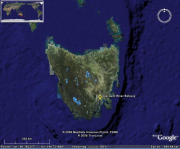Biosphere | Ecological Dynamics | Competition
Type of resources
Topics
Keywords
Contact for the resource
Provided by
Years
-

This study reports on previously undescribed predation on Asterias amurensis in the Derwent Estuary, Tasmania by the spider crab Leptomithrax gaimardii (Milne Edwards). Specifically, this study describes the predatory interaction between the spider crab and A. amurensis and quantifies patterns of sub-lethal injuries inflicted on the seastar during a localised aggregation of the spider crab.
-
We used an in situ manipulative experiment to assess the impacts of the introduced New Zealand screwshell, Maoricolpus roseus, on native soft-sediment community structure and habitat characteristics in SE Tasmania. Impacts were assessed for high and low screwshell density and for the effect of live and dead screwshells, as well as those containing hermit crabs.
-
The impact of the introduced New Zealand screw shell, Maoricolpus roseus, were assessed using a cageing experiment in SE Tasmania (Bligh Point, D'Entrecasteaux Channel). Three treatments consisted of different substratum type (live, dead and empty shells, and dead shells with 50% occupancy by hermit crabs); which were crossed with 2 levels of screwshell density (high and low). Treatment groups were artificially maintained for 20 months before metabolic chambers were used to quantify the community metabolism of different treatment groups.
-
Impacts of New Zealand screwshells (Maoricolpus roseus) on native scallop distribution and behaviour
The impact of the introduction of the New Zealand screwshell (Maoricolpus roseus) on scallop distribution and behaviour in the D'Entrecasteaux Channel, SE Tasmania was investigated. The impact of both live and dead and empty M. roseus shells on the distribution of two sympatric scallop species, queen scallop (Equichlamys bifrons) and doughboy scallop (Chlamys asperrimus) was quantified at large spatial scales. Also quantified was the impact of M. roseus on the distribution and behaviour of the commercial scallop (Pecten fumatus), at both large and small spatial scales.
-
The impact of the introduction of the New Zealand screwshell (Maoricolpus roseus) on growth, condition and survivorship of juvenile scallops (Pecten fumatus) at Bligh Point in the D'Entrecasteaux Channel, SE Tasmania was investigated. A manipulative experiment was used to quantity the impact associated with live and dead M. roseus shells and to quantify differences in interspecific and intraspecific competition.
 IMAS Metadata Catalogue
IMAS Metadata Catalogue